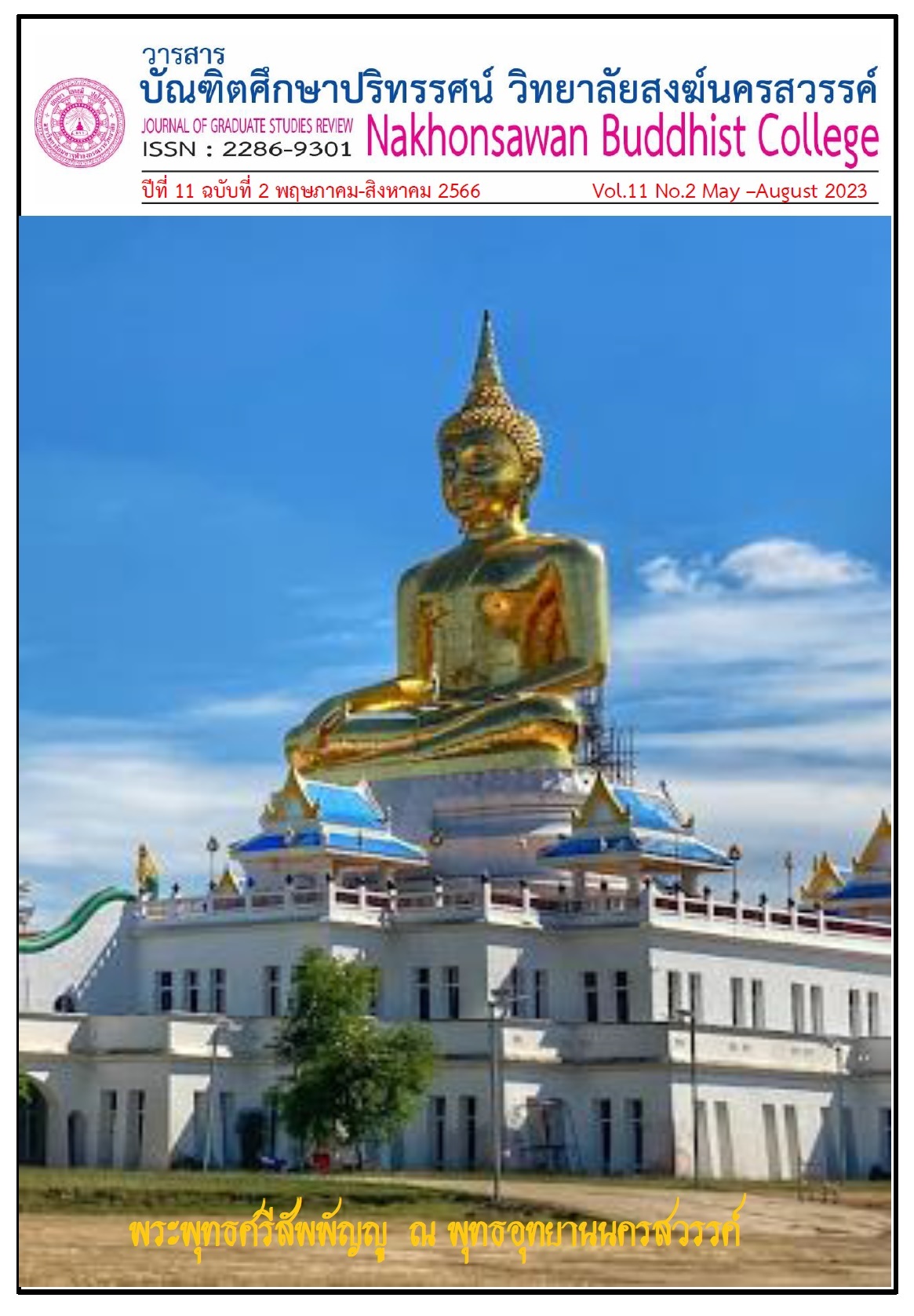ศึกษาวิเคราะห์ความสัมพันธ์ระหว่างพระพุทธศาสนากับวงปี่พาทย์เครื่องห้า
Main Article Content
บทคัดย่อ
บทความวิจัยนี้ มีวัตถุประสงค์ 3 ประการคือ 1) เพื่อศึกษาความเป็นมาของวงปี่พาทย์เครื่องห้า 2) เพื่อศึกษาความสัมพันธ์ของพระพุทธศาสนากับดนตรี 3) เพื่อวิเคราะห์ความสัมพันธ์ระหว่างพระพุทธศาสนากับวงปี่พาทย์เครื่องห้า งานวิจัยฉบับนี้เป็นงานวิจัยเชิงคุณภาพ โดยมีการวิเคราะห์ข้อมูลภาคเอกสาร ผลการวิจัยพบว่า1) วงปี่พาทย์เครื่องห้า เป็นวงดนตรีที่มีผู้รู้หลายท่านให้ความเห็นแตกต่างกันถึงการเกิดขึ้นของวง กล่าวคือ บางท่านให้ความเห็นว่าเป็นวงดนตรีที่เกิดขึ้นแล้วตั้งแต่สมัยสุโขทัย แต่บางท่านให้ความเห็นว่า เป็นวงดนตรีที่เกิดขึ้นในสมัยอยุธยา เป็นวงดนตรีไทยประเภทหนึ่งอันประกอบด้วยเครื่องเป่า และเครื่องตี เป็นวงปี่พาทย์ที่เป็นวงหลัก มีจำนวนเครื่องดนตรีน้อยชิ้นที่สุด ได้แก่ (1) ปี่ใน 1 เลา (2) ระนาดเอก 1 ราง (3) ฆ้องวงใหญ่ 1 วง (4) กลองทัด 1 คู่ (5) ตะโพน 1 ลูกและมีฉิ่ง เป็นเครื่องกำกับจังหวะ สันนิษฐานว่ามีต้นกำเนิดจากวงแตรสังข์ ซึ่งประประโคมในพิธีต่างๆ ตามวัฒนธรรมแบบอินเดียที่ส่งอิทธิพลเข้ามายังประเทศไทย ประกอบด้วย สังข์ เป็นเปลือกหอยชนิดหนึ่งนำมาขัดแล้วเจาะรูตรงก้นหอยแล้วใช่ริมฝีปากเป่ามีเสียงดังไกลกังวาล บางครั้งเรียกว่า “แตรสังข์” ใช้เป็นเครื่องประโคมในพิธีกรรมเป็นส่วนใหญ่ต่อมาจึงนำแตรงอน ที่ประดิษฐ์ขึ้นเพื่อใช้แทนสังข์ที่หายากขึ้น แตรงอนเป็นเครื่องดนตรีประเภทเครื่องเป่าทำด้วยโลหะ มีลักษณะงอนช้อนขึ้นคล้ายกับสังข์มาประสมด้วย ซึ่งแตรงอนสามารถเปล่งเสียงได้ไกลกว่าสังข์มาก จึงใช้เป็นเครื่องประโคมในพระราชพิธีเพื่องสร้างบรรยากาศเพราะมีระบบเสียงไม่กี่เสียง วงปี่พาทย์จึงได้รับอิทธิพลของเครื่องเป่าเข้ามาผสมกับเครื่องตีประเภทกลองที่อาจมีอยู่แล้ว และปรับปรุงให้เหมาะสมกับวัฒนธรรมของตน 2) ความสัมพันธ์ของพระพุทธศาสนากับดนตรีนั้น เสียงดนตรีแบ่งเป็นสองนัย คือ ดีก็มีแล้วก็ไม่ดีก็มี ในพระพุทธศาสนาจึงมีข้อห้ามไว้ในพระวินัยไม่ให้พระฟังดนตรีอยู่ในอุโบสถศีลข้อเจ็ดนัจจะ คีตะ วาทิตะ วิสูกทัสสนา เวรณี สิกขาปทัง สมาทิยามิ คือเว้นจากการฟ้อนรำขับร้องประโคมดนตรีและดูการละเล่นอันเป็นค่าศึกษาแห่งกุศลท่านพระสิริมังคลาจารย์ ผู้รจนาคัมภีร์มังคลัตถทีปนี ก็เปิดทางให้การฟังคีตะดนตรี ที่ไม่เป็นวิสูกะ บางคราวฟังได้แล้วท่านยกเอาอรรถาธิบายในคัมภีร์สุมังคลาสินี ตอนกล่าวแก่สักปัญหาสูตรมากล่าวว่าเสียงชนิดใดแม้มีอักขระและพยัญชนะ วิจิตรสละสลวย แต่เมื่อฟังแล้วก่อให้เกิดราคกิเลส เสียงเห็นปานนี้ไม่ควรส้องเสพคบหา แต่ถ้าว่าเสียงชนิดใดที่ประกอบด้วยอัฏฐและธรรมะแม้แต่นางกุมภาทาสีเมื่อฟังแล้วก่อให้เกิดความเลื่อมใสศรัทธาในพระรัตนตรัยหรือก็ได้เกิดความเบื่อหน่ายสังสารวัฏเสียงเช่นนี้ควรสดับรับฟังได้ซึ่งเป็นเรื่องเกี่ยวกับพื้นฐานอารมณ์ของผู้ฟัง และ 3) วิเคราะห์ความสัมพันธ์ของพระพุทธศาสนากับวงปี่พาทย์เครื่องห้า พบว่า ความสัมพันธ์ของพระพุทธศาสนาและวงปีพาทย์เครื่องห้า ที่ได้ถูกนำมาช่วยเหลือเกื้อกูลหน้าที่ของกันและกัน โดยพระพุทธศาสนาได้กลายเป็นปัจจัยให้เกิดผลทางดนตรี สร้างสัมมาชีพและความสามัคคีแก่ชุมชน วงปีพาทย์เครื่องห้า เป็นวงดนตรีเล็กๆ ที่ส่งผ่านมาจากอารยธรรมในอดีต กลายมาเป็นสมบัติของบรรพชนไทย นำมาเป็นเครื่องสักการะที่แสดงความเคารพบูชาต่อพระรัตนตรัย ผ่านการคิดทบทวนก่อนจะนำมารับใช้ในพิธีกรรมทางศาสนา วางบทบาทที่เหมาะสม สร้างความมีวินัยเบื้องต้นแก่นักผู้บรรเลงและผู้ฟัง สร้างความภาคภูมิใจและปีติใจ แก้ปัญหาความเครียดทางสังคมในระดับหนึ่ง ในขณะเดียวกัน การวางท่าทีของศาสนบุคคล ด้วยความมั่นคงในสมาธิไม่หวั่นไหวด้วยเสียงดนตรี ได้เป็นแบบอย่างที่ดีแก่ศาสนิกชน การบัญญัติชื่อแก่บทเพลงบรรเลงของวงปี่พาทย์เครื่องห้า ที่สื่อถึงเหตุการณ์สำคัญในพระพุทธศาสนา และสื่อให้ระลึกถึงธรรม นับเป็นปัจจัยหนึ่งที่สื่อให้เกิดความสงบระงับใจ กระตุ้นเตือนในการรักษาจิตไม่ให้หวั่นไหวด้วยกิเลสบาปธรรม มุ่งหน้าไปสู่มรรคผลนิพพาน และนำความสุขมาให้แก่สรรพสัตว์ อันเป็นอุดมคติสูงสุดในพระพุทธศาสนา


